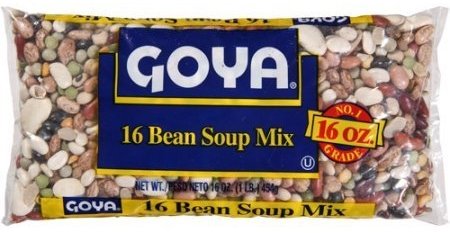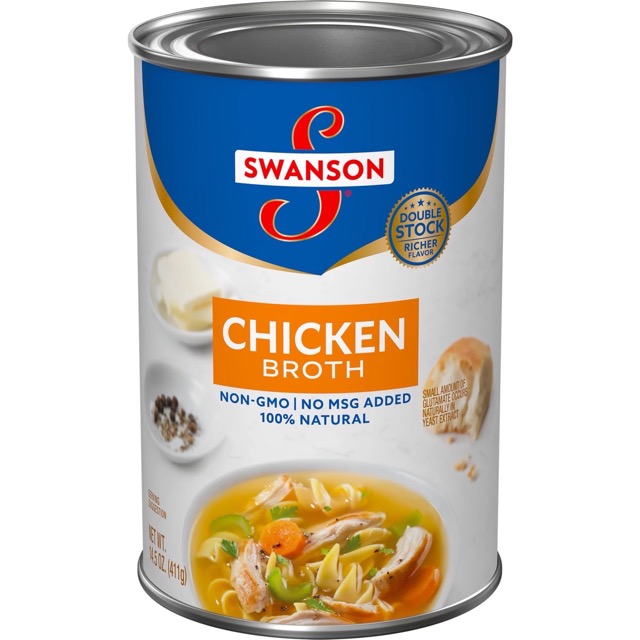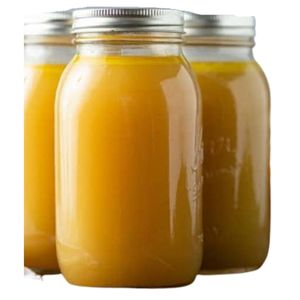This week’s blog is a continuation of the theme from last week’s blog on soup, the ultimate survival food. In that blog you learned about storing commercially canned soups and dehydrated soup mixes. This week the challenge is to stock up on soup-making ingredients so that you have what you need to make your own favorite homemade soups. With just a few basic ingredients, you will be able to provide a hearty, nutritious meal that can bring a sense of normalcy in crazy times.

You probably have your favorite soup recipes. And with abundant regional and ethnic possibilities and bloggers eager to share their favorite soup recipe, it’s easy to find new recipes to try. If you are like me, you probably start with someone else’s recipe and then adjust it to fit the ingredients you have and what your family likes.
Week 45 Preparedness Challenge
This week the preparedness challenge is to add the ingredients for making your favorite soups to your food storage.
This week’s challenge is to have enough ingredients for five or more different soup recipes.
Stock Up to Make Your Own Soups
A can of soup can be a fast solution in an emergency, but honestly, canned soups don’t compare to a rich, homemade soup. The solution is to store the ingredients that you need to make your favorite homemade soups.
You may need to alter recipes a bit—for example, use evaporated or dry milk instead of fresh milk, or canned vegetables and dehydrated cheese instead of fresh vegetables or cheese. The result may be a little different from the homemade soup you usually make, but it will be superior to canned soup and comforting meal when life might be chaotic.
Ingredients You Need to Make Five Popular Soups
One strategy for storing soup makings is to assemble ingredients with specific soup recipes in mind. In case you need some inspiration about what to store to make soups, here are lists of basic ingredients for making five popular soups. Add these ingredients to your preparedness pantry and use your own favorite recipe to put the ingredients together. Add any additional ingredients you like to use.
CHICKEN NOODLE SOUP

- Canned, frozen, or freeze-dried chicken breast
- Chicken broth
- Dehydrated or fresh onions, carrots, celery, garlic
- Noodles, dry, frozen, or homemade
- Bayleaf, parsley, thyme, sage
CREAMY TOMATO BASIL SOUP
- Canned tomatoes
- Chicken broth
- Dehydrated or fresh onions
- Basil, fresh, frozen, or dry
- Garlic cloves or powder
- Salt
- Parmesan cheese
- Canned coconut milk
NEW ENGLAND CLAM CHOWDER

- Canned clams
- Chicken broth
- Fresh, canned, or dehydrated potatoes
- Fresh or dehydrated onions and celery
- Bacon pieces
- Dry milk or evaporated milk
MINESTRONE SOUP
- Hamburger, canned or freeze-dried beef
- Beef or vegetable broth
- Fresh or dried onion
- Canned tomatoes, tomato sauce
- Canned green beans
- Fresh or canned carrots
- Cannellini, Great Northern white beans, or garbanzo beans, dry or canned
- Elbow or small shell pasta
- Fresh or dried garlic
- Italian seasonings, red pepper flakes
CHILI
- Hamburger or canned or freeze-dried beef
- Pinto beans, dry or canned
- Black beans, dry or canned
- Kidney beans, dry or canned
- Onions, fresh or dehydrated
- Canned tomatoes
- Tomato sauce
- Chili peppers, fresh, dried, or canned
- Chili powder, cumin, garlic powder, paprika, cayenne
Get the Ingredients You Need to Make Three Basic Types of Soups
Another strategy for stocking up on soup ingredients is to assemble a few generic ingredients that are basics for lots of soups. Then you will have what you need to make a variety of delicious, nutritious pots of soup. We’ll take a look at what you need in your preparedness pantry for three basic types of soup. Especially store any additional ingredients that will let you make your favorite soup recipes.
THREE BASIC SOUP GROUPS
- Creamy soups
- Bean soups
- Broth-based soups
Stock Up to Make Classic Creamy Soups
The main ingredients in creamy soups are pureed vegetables along with broth, onions, herbs, and milk products. They may be thickened using a roux. There are countless variations of creamy soups. Here is a list of some of the most popular.
POPULAR CREAMY SOUPS

- Cream of Tomato Basil Soup
- Butternut Squash Soup
- Cream of Mushroom Soup
- Creamy Broccoli and Cheddar Soup
- Potato Soup
- Roasted Cauliflower Soup
What You Need to Store to Make Creamy Soups
With a few basic ingredients you can make a nice variety of creamy soups. The list below will give you a good starting place.

- Vegetables such as tomatoes, potatoes, squash, broccoli, cauliflower, etc.
- Milk: Dry milk, evaporated milk, shelf-stable milk, or fresh milk
- Milk substitute: canned coconut milk
- Onions and garlic
- Chicken or vegetable broth
- Cheese, fresh, frozen, or dehydrated
- Butter or olive oil
- Flour
Stock Up to Make Classic Bean Soups
Bean soup can be made from dry beans, canned beans, and bean mixes. Each has advantages and disadvantages. Keep in mind that to make bean soup, you are going to need more than beans–you will need additional ingredients to make a tasty soup.
DRY BEANS
Advantages
- Economical
- Widely available
- Easy to prepare
- Long storage life—up to 25 years if stored in a sealed container with oxygen absorbers
Disadvantages
- Dry beans can take a long time to cook. Beans benefit from soaking, an easy, but additional preparation step.
- Require water to use
CANNED BEANS
Advantages
- Cooked and ready to use
- Easy to prepare
- Convenient
- Don’t require much energy to use
- Packable and sharable
Disadvantages
- Most expensive way to purchase beans
- Heavy
- Less efficient use of space
BEAN SOUP MIX
Advantages

- Convenient because they already contain ten to fifteen different beans so you don’t have to mix your own
- Purchased mixes often contain unique beans not readily available
- Easy to prepare
- Long storage life—up to 25 years if stored in a sealed container with oxygen absorbers
Disadvantages
- More expensive than indiidual dried beans
- Most mixes require that you add extra ingredients like onions, celery, and various herbs and spices that will need to be stored as well
What You Need to Store to Make Bean Soups
You will need a selection beans and legumes, a nice variety of herbs and spices, and perhaps some meat for soups like navy bean soup or chili. The list below will help you gather bean-soup ingredients to put in your food storage.
BEAN SOUP INGREDIENTS
- Beans, either canned or dry—pintos, black, white, kidney, garbanzo, etc.
- Legumes—lentils and split peas
- Stored fresh or dehydrated—onions, celery, carrots, green peppers
- Beef or ham—frozen, canned, or freeze-dried
- Hamburger
- Hambones—frozen
- Savory herbs and spices like parsley, sage, thyme, basil, peppercorns
- Chili-making spices like chili powder, cumin, chili peppers, garlic,
Stock Up to Make Broth-Based Soups
Broth is the foundational flavor in broth-based soups. Broth-based soups like vegetable beef, chicken noodle, French onion, and minestrone begin with a flavorful broth. Along with the broth, they usually include a meat, vegetables, a grain, and savory herbs. If you have these ingredients you can make a tasty soup. Canned tomatoes are also in many broth-based soups.
Prepared Broth Makes it Easy to Make Soup

Purchasing commercially prepared broth is the easiest way to have broth on hand. Choose from ready-to-use broth in cans or cartons. Or choose bouillon in cubes, flakes, grains, or concentrated food base.
SHELF LIFE OF COMMERCIALLY PREPARED BOUILLON
Broth in cans and cartons has a storage life of two to three years. Bouillon has a “best by” date of 18 to 24 months, but if stored in a cool place, that shelf life can be double. A concentrated food base such as Better Than Bouillon should be stored in the refrigerator after opening, and the manufacturer recommends following the stated “best by” date which is about two years from the time of manufacturing.
DRIED ONION SOUP MIX
Dry soup mixes such as Lipton Onion Soup Mix makes an oniony broth and can be used as a soup base, especially in beef soups. It is also an ingredient in many recipes and can add flavor to basic storage foods.
HOMEMADE ONION SOUP MIX
Keep the ingredients on hand so you can make your own onion soup mix. This homemade version is a snap to put together and comes from the Spend with Pennies website.
Onion Soup Mix Ingredients:
- 1/3 cup dehydrated onion flakes
- 7 tablespoons beef bouillon granules
- 1/2 teaspoon onion powder
- 1/2 teaspoon paprika
- 1/4 garlic powder
- 1/2 teaspoon black pepper
- Five tablespoons equal one packet of soup mix.
- Store up to six months in a sealed container.
Make Your Own Broth for Broth-Based Soups
Though a bit of a chore to make, homemade broth is rich and flavorful. Ideally, make your own broth using bony parts of chicken, turkey, or beef along with onions, celery, carrots, herbs, peppercorns, and salt. Make a large batch of broth when it is convenient, and freeze or pressure can it so that it will be ready-to-go when needed. Check out the recipes below for making chicken, beef, and vegetable broth.
CHICKEN- OR TURKEY-BASED BROTH
Place the following in an 8-quart stock pot with 12 to 16 cups of water.

- Carcass of one rotisserie chicken (meat removed for another purpose) or carcass of one roasted turkey. Or roast chicken parts like thighs and drumsticks, remove the meat, and use the bones in the broth.
- 3 to 4 stalks of celery, use the inner leafy stalks or stronger-flavored outer stalks
- 2 large onions, peeled and quartered
- 2 bay leaves
- Add other savory herbs of your choice: parsley, sage, thyme, marjoram, rosemary
- 10 peppercorns
- 1 tablespoon of salt
Simmer broth for two hours. Strain, cool, remove solidified fat. Freeze strained broth in two- or four-cup containers or in ice cube trays for small portions, or pressure-can at 10 pounds of pressure for twenty minutes.
BEEF-BASED BROTH
Roast meaty beef bones and vegetables fin a large pan at 400 degrees for 40 minutes until beef and vegetables are browned.
- 4 to 5 pounds of meaty beef bones—bones could be saved from steak, rib roast, etc., frozen, and used when you have enough
- 1 pound of stew meat or similar meat cut in 2-inch chunks
- 2 medium onions, quartered
- 2 large carrots, washed, quartered, and cut in 3-inch pieces
- 2 stalks of celery, including leaves, cut in 1-inch chunks
Place in 8-quart stock pot:
- Roasted meat, bones, and vegetables
- Fresh parsley
- 2 bay leaves
- 10 peppercorns
Simmer on low heat for three to four hours. Strain, cool, remove solidified fat. Freeze broth in two- or four-cup containers or in ice cube trays for small portions, or pressure can at 10 pounds of pressure for twenty minutes.
VEGETABLE-BASED BROTH
Sauté first five vegetables in a little olive oil.
- 3 to 4 ribs of celery and leafy part, chopped
- 2 onions, chopped
- 3 carrots,
- 5 cloves of garlic
- ½ pound of mushrooms (optional)
- Add other vegetables of your choice: red pepper, zucchini, tomatoes (avoid the cabbage family)
- Add parsley and thyme sprigs and two bay leaves
- Add other herbs of your choice: rosemary, basil, leek top, pepper corn
Place ingredients soup pot with 8 cups of water and simmer for one to two hours. Strain broth and freeze in two- or four-cup containers or in ice cube trays for small portions, or pressure-can at 10 pounds of pressure for twenty minutes.
Make Homemade Broth as Needed
The second option for making broth is to store the ingredients needed to make your favorite broth-based soups and then, simply make the broth as needed as part of the whole soup-making process.
What You Need to Store to Make Broth-Based Soups
Your preparedness pantry needs a selection of general ingredients to make soups. The generic list that follows is a good starting place, but also consider your favorite soup recipes and what ingredient you need to make them.
BROTH-BASED SOUP INGREDIENTS
- Broth: chicken, beef, and vegetable broth, canned, or ingredients for making your own
- Stored fresh or dehydrated—onions, celery, carrots
- Other vegetables of your choice: fresh, canned, or dehydrated
- Beef, including hamburger, or chicken—frozen, canned, or freeze-dried
- Canned tomatoes, tomato sauce, or dehydrated tomato powder
- Potatoes—fresh, canned, or dehydrated
- Grains—noodles, pasta, rice, barley
- Savory herbs and spices like parsley, sage, thyme, basil, peppercorns
Use Condensed Soups to Jazz-Up Broth-Based Soup
Condensed cream of mushroom, chicken, and celery soups are useful thickening broth-based soup. For example, combining cream of chicken soup and chicken noodle soup.
Learn More

In my book Crisis Preparedness Handbook, Third Edition, find out more about storing different kinds of foods. You will get valuable checklists, quick-start ideas, worksheets, and personal tips to make it easy. Also learn about water storage, sanitation, communication, transportation, etc. You can find it on Amazon as a hard copy and in Kindle or on my website CrisisPreparedness.com.sis


